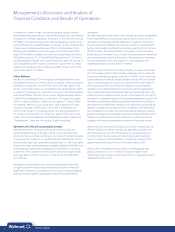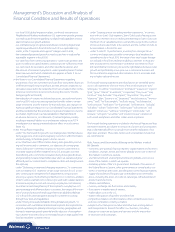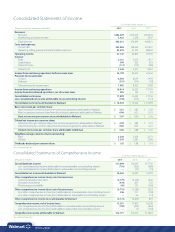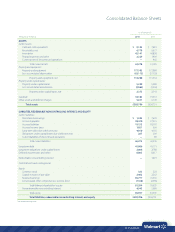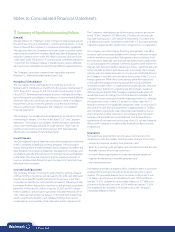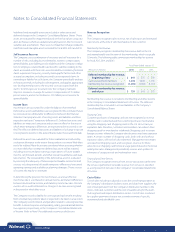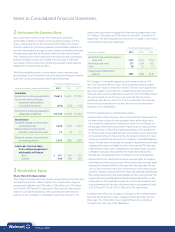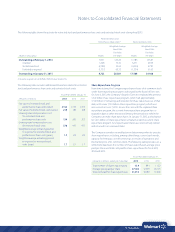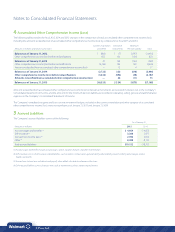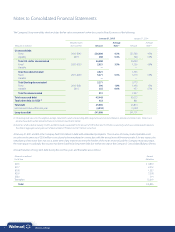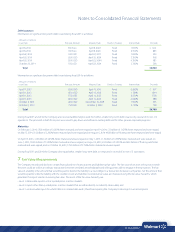Walmart 2015 Annual Report Download - page 42
Download and view the complete annual report
Please find page 42 of the 2015 Walmart annual report below. You can navigate through the pages in the report by either clicking on the pages listed below, or by using the keyword search tool below to find specific information within the annual report.
40 2015 Annual Report
1 Summary of Signicant Accounting Policies
General
Wal-Mart Stores, Inc. (“Walmart” or the “Company”) helps people around
the world save money and live better – anytime and anywhere – in retail
stores or through the Company’s e-commerce and mobile capabilities.
Through innovation, the Company is striving to create a customer-centric
experience that seamlessly integrates digital and physical shopping. Each
week, the Company serves nearly 260 million customers who visit its over
11,000 stores under 72 banners in 27 countries and e-commerce websites in
11 countries. The Company’s strategy is to lead on price, invest to differenti-
ate on access, be competitive on assortment and deliver a great experience.
The Company’s operations comprise three reportable segments:
Walmart U.S., Walmart International and Sam’s Club.
Principles of Consolidation
The Consolidated Financial Statements include the accounts of
Walmart and its subsidiaries as of and for the fiscal years ended January 31,
2015 (“fiscal 2015”), January 31, 2014 (“fiscal 2014”) and January 31, 2013
(“fiscal 2013”). All material intercompany accounts and transactions have
been eliminated in consolidation. Investments in unconsolidated affiliates,
which are 50% or less owned and do not otherwise meet consolidation
requirements, are accounted for primarily using the equity method.
These investments are immaterial to the Company’s Consolidated
Financial Statements.
The Company’s Consolidated Financial Statements are based on a fiscal
year ending on January 31, for the United States (“U.S.”) and Canadian
operations. The Company consolidates all other operations generally
using a one-month lag and based on a calendar year. There were no
significant intervening events during January 2015 that materially
affected the Consolidated Financial Statements.
Use of Estimates
The Consolidated Financial Statements have been prepared in conformity
with U.S. generally accepted accounting principles. Those principles
require management to make estimates and assumptions that affect the
reported amounts of assets and liabilities. Management’s estimates and
assumptions also affect the disclosure of contingent assets and liabilities
at the date of the financial statements and the reported amounts of
revenues and expenses during the reporting period. Actual results may
differ from those estimates.
Cash and Cash Equivalents
The Company considers investments with a maturity when purchased
of three months or less to be cash equivalents. All credit card, debit card
and electronic benefits transfer transactions that process in less than
seven days are classified as cash and cash equivalents. The amounts due
from banks for these transactions classified as cash and cash equivalents
totaled $2.9 billion and $1.6 billion at January 31, 2015 and 2014, respec-
tively. In addition, cash and cash equivalents included restricted cash of
$345 million and $654 million at January 31, 2015 and 2014, respectively,
which was primarily related to cash collateral holdings from various
counterparties, as required by certain derivative and trust agreements.
The Company’s cash balances are held in various locations around the
world. Of the Company’s $9.1 billion and $7.3 billion of cash and cash
equivalents at January 31, 2015 and 2014, respectively, $6.3 billion and
$5.8 billion, respectively, were held outside of the U.S. and were generally
utilized to support liquidity needs in the Company’s non-U.S. operations.
The Company uses intercompany financing arrangements in an effort
to ensure cash can be made available in the country in which it is needed
with the minimum cost possible. Management does not believe it will
be necessary to repatriate cash and cash equivalents held outside of the
U.S. and anticipates the Company’s domestic liquidity needs will be met
through cash flows provided by operating activities, supplemented with
long-term debt and short-term borrowings. Accordingly, the Company
intends, with only certain exceptions, to continue to indefinitely reinvest
the Company’s cash and cash equivalents held outside of the U.S. in our
foreign operations. When the income earned, either from operations
or through intercompany financing arrangements, and indefinitely
reinvested outside of the U.S. is taxed at local country tax rates, which are
generally lower than the U.S. statutory rate, the Company realizes an
effective tax rate benefit. If the Company’s intentions with respect to
reinvestment were to change, most of the amounts held within the
Company’s foreign operations could be repatriated to the U.S., although
any repatriation under current U.S. tax laws would be subject to U.S.
federal income taxes, less applicable foreign tax credits. As of January 31,
2015 and 2014, cash and cash equivalents of approximately $1.7 billion
and $1.9 billion, respectively, may not be freely transferable to the U.S.
due to local laws or other restrictions. The Company does not expect
local laws, other limitations or potential taxes on anticipated future
repatriations of cash amounts held outside of the U.S. to have a material
effect on the Company’s overall liquidity, financial condition or results
of operations.
Receivables
Receivables are stated at their carrying values, net of a reserve for
doubtful accounts. Receivables consist primarily of amounts due from:
• insurance companies resulting from pharmacy sales;
• banks for customer credit and debit cards and electronic bank transfers
that take in excess of seven days to process;
• consumer financing programs in certain international operations;
• suppliers for marketing or incentive programs; and
• real estate transactions.
The Walmart International segment offers a limited number of consumer
credit products, primarily through its financial institutions in select
markets. The receivable balance from consumer credit products was
$1.2 billion, net of a reserve for doubtful accounts of $114 million at
January 31, 2015, compared to a receivable balance of $1.3 billion, net
of a reserve for doubtful accounts of $119 million at January 31, 2014.
These balances are included in receivables, net, in the Company’s
Consolidated Balance Sheets.
Notes to Consolidated Financial Statements




